BUSN20017: Analyzing Communication Styles for Australian Businesses
VerifiedAdded on 2022/09/28
|10
|2798
|20
Report
AI Summary
This report examines business communication strategies within the Australian agricultural sector, emphasizing the need for effective communication as companies expand and hire diverse workforces. It explores both competent and incompetent communication styles, focusing on the importance of computer-mediated communication (CMC) and nonverbal communication for new employees. The report highlights the significance of understanding different communication preferences in a multicultural environment to mitigate conflicts and foster a cohesive workplace. It recommends CMC and nonverbal communication as effective strategies, while cautioning against the limitations of written and verbal communication in international settings. The conclusion underscores the role of strategic communication in achieving organizational goals and competitive advantage within the context of globalization.

BUSN20017
INSTITUTIONAL AFFILIATION(s)
STUDENT NAME
INSTITUTIONAL AFFILIATION(s)
STUDENT NAME
Paraphrase This Document
Need a fresh take? Get an instant paraphrase of this document with our AI Paraphraser
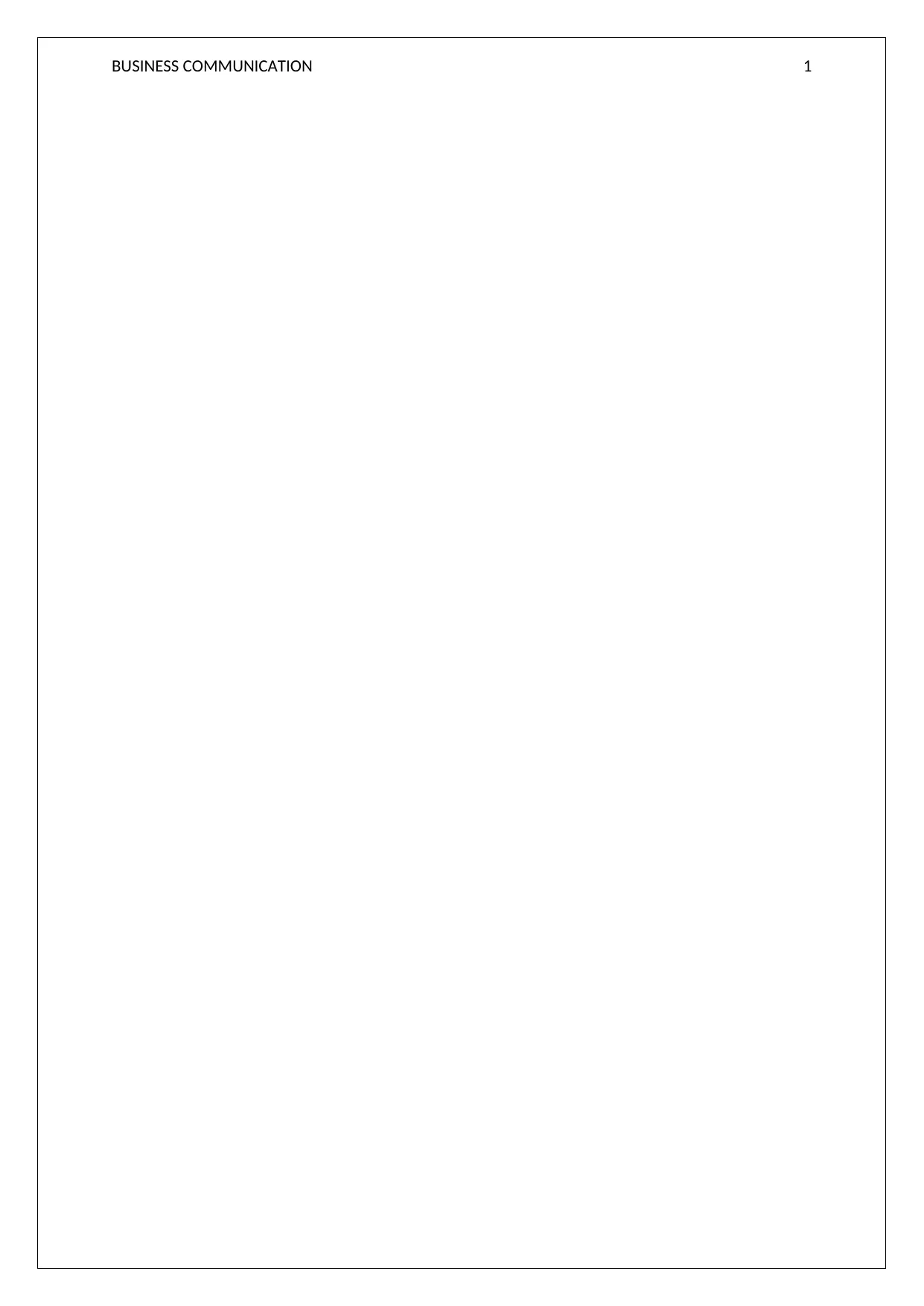
BUSINESS COMMUNICATION 1
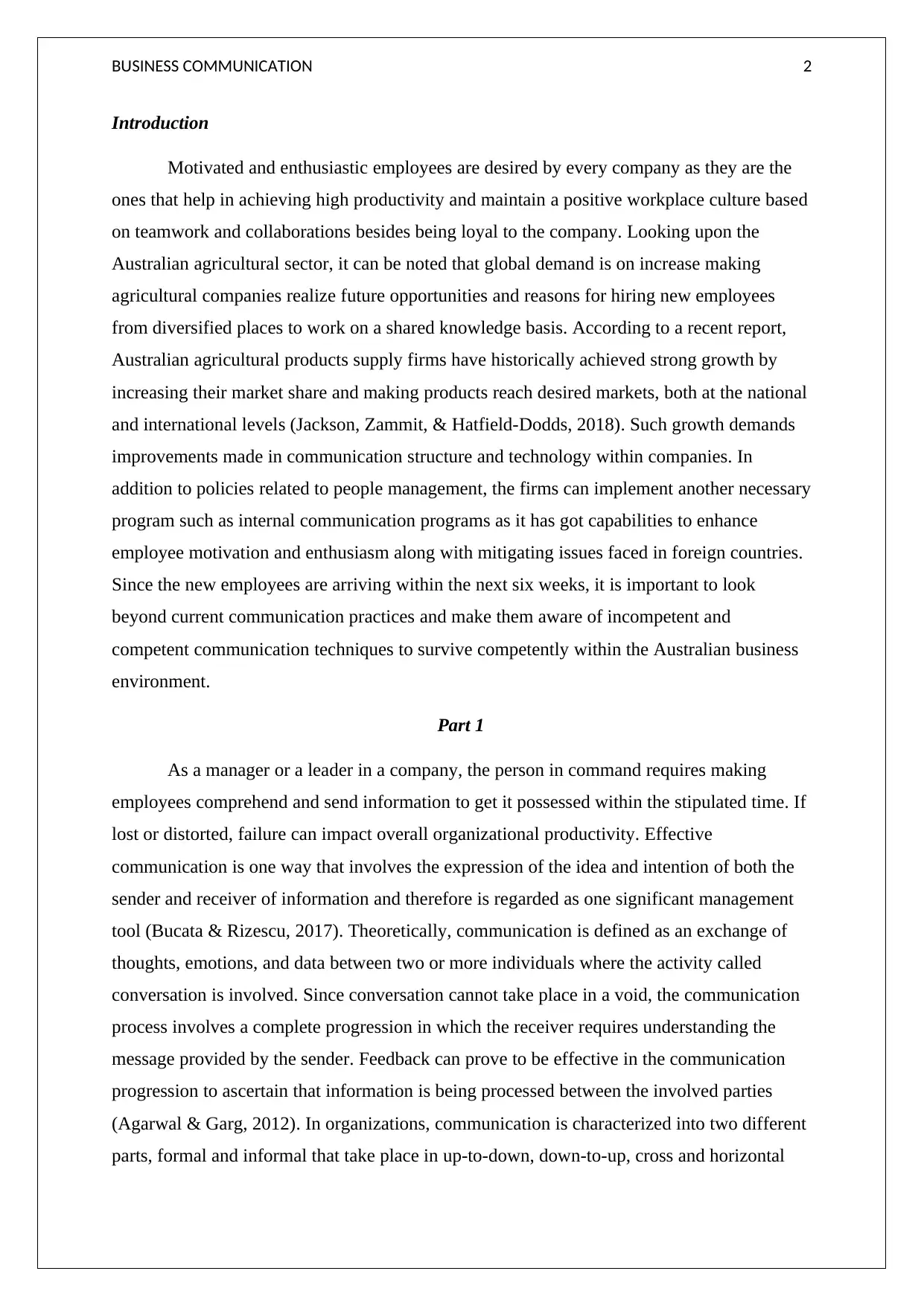
BUSINESS COMMUNICATION 2
Introduction
Motivated and enthusiastic employees are desired by every company as they are the
ones that help in achieving high productivity and maintain a positive workplace culture based
on teamwork and collaborations besides being loyal to the company. Looking upon the
Australian agricultural sector, it can be noted that global demand is on increase making
agricultural companies realize future opportunities and reasons for hiring new employees
from diversified places to work on a shared knowledge basis. According to a recent report,
Australian agricultural products supply firms have historically achieved strong growth by
increasing their market share and making products reach desired markets, both at the national
and international levels (Jackson, Zammit, & Hatfield-Dodds, 2018). Such growth demands
improvements made in communication structure and technology within companies. In
addition to policies related to people management, the firms can implement another necessary
program such as internal communication programs as it has got capabilities to enhance
employee motivation and enthusiasm along with mitigating issues faced in foreign countries.
Since the new employees are arriving within the next six weeks, it is important to look
beyond current communication practices and make them aware of incompetent and
competent communication techniques to survive competently within the Australian business
environment.
Part 1
As a manager or a leader in a company, the person in command requires making
employees comprehend and send information to get it possessed within the stipulated time. If
lost or distorted, failure can impact overall organizational productivity. Effective
communication is one way that involves the expression of the idea and intention of both the
sender and receiver of information and therefore is regarded as one significant management
tool (Bucata & Rizescu, 2017). Theoretically, communication is defined as an exchange of
thoughts, emotions, and data between two or more individuals where the activity called
conversation is involved. Since conversation cannot take place in a void, the communication
process involves a complete progression in which the receiver requires understanding the
message provided by the sender. Feedback can prove to be effective in the communication
progression to ascertain that information is being processed between the involved parties
(Agarwal & Garg, 2012). In organizations, communication is characterized into two different
parts, formal and informal that take place in up-to-down, down-to-up, cross and horizontal
Introduction
Motivated and enthusiastic employees are desired by every company as they are the
ones that help in achieving high productivity and maintain a positive workplace culture based
on teamwork and collaborations besides being loyal to the company. Looking upon the
Australian agricultural sector, it can be noted that global demand is on increase making
agricultural companies realize future opportunities and reasons for hiring new employees
from diversified places to work on a shared knowledge basis. According to a recent report,
Australian agricultural products supply firms have historically achieved strong growth by
increasing their market share and making products reach desired markets, both at the national
and international levels (Jackson, Zammit, & Hatfield-Dodds, 2018). Such growth demands
improvements made in communication structure and technology within companies. In
addition to policies related to people management, the firms can implement another necessary
program such as internal communication programs as it has got capabilities to enhance
employee motivation and enthusiasm along with mitigating issues faced in foreign countries.
Since the new employees are arriving within the next six weeks, it is important to look
beyond current communication practices and make them aware of incompetent and
competent communication techniques to survive competently within the Australian business
environment.
Part 1
As a manager or a leader in a company, the person in command requires making
employees comprehend and send information to get it possessed within the stipulated time. If
lost or distorted, failure can impact overall organizational productivity. Effective
communication is one way that involves the expression of the idea and intention of both the
sender and receiver of information and therefore is regarded as one significant management
tool (Bucata & Rizescu, 2017). Theoretically, communication is defined as an exchange of
thoughts, emotions, and data between two or more individuals where the activity called
conversation is involved. Since conversation cannot take place in a void, the communication
process involves a complete progression in which the receiver requires understanding the
message provided by the sender. Feedback can prove to be effective in the communication
progression to ascertain that information is being processed between the involved parties
(Agarwal & Garg, 2012). In organizations, communication is characterized into two different
parts, formal and informal that take place in up-to-down, down-to-up, cross and horizontal
⊘ This is a preview!⊘
Do you want full access?
Subscribe today to unlock all pages.

Trusted by 1+ million students worldwide
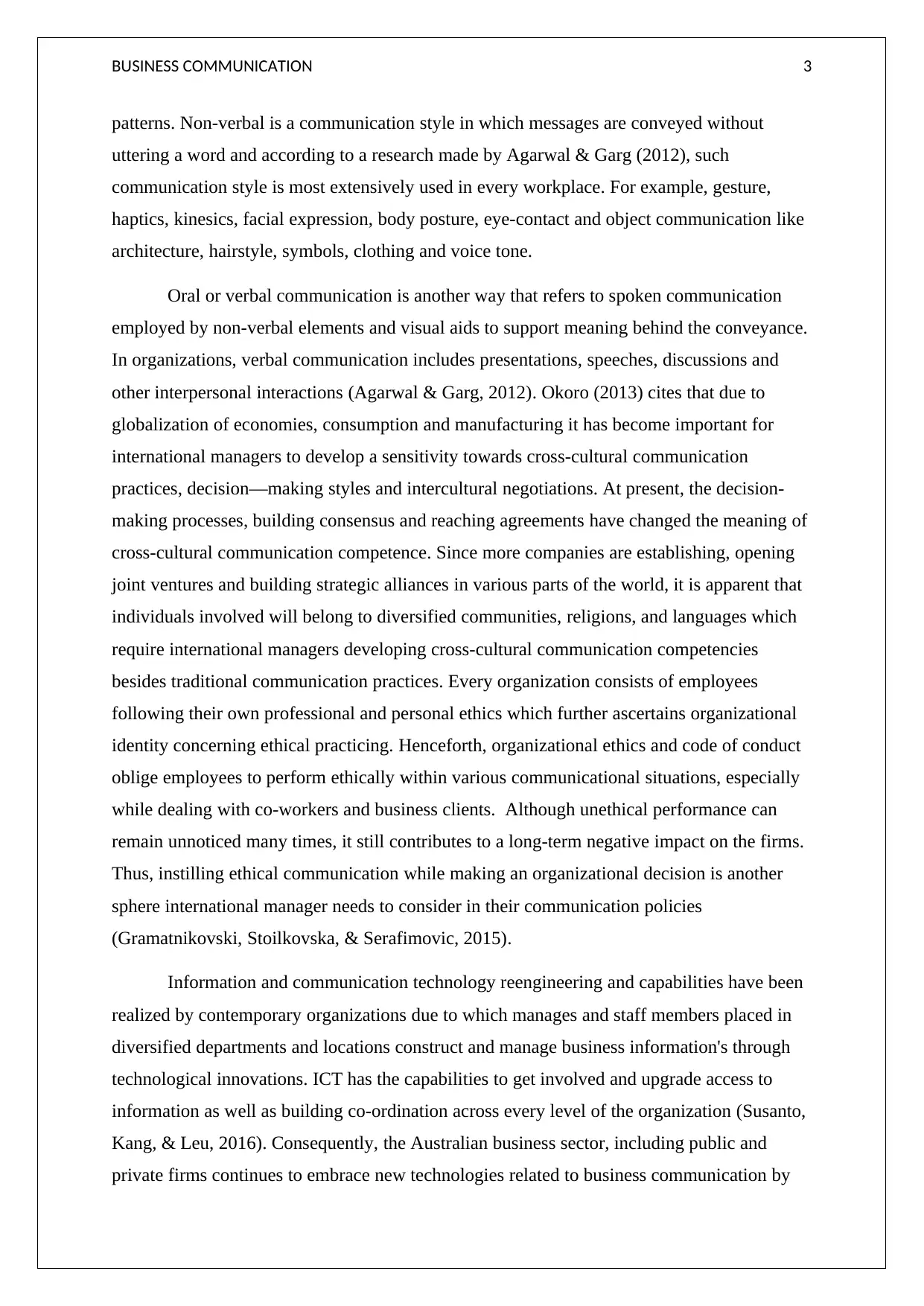
BUSINESS COMMUNICATION 3
patterns. Non-verbal is a communication style in which messages are conveyed without
uttering a word and according to a research made by Agarwal & Garg (2012), such
communication style is most extensively used in every workplace. For example, gesture,
haptics, kinesics, facial expression, body posture, eye-contact and object communication like
architecture, hairstyle, symbols, clothing and voice tone.
Oral or verbal communication is another way that refers to spoken communication
employed by non-verbal elements and visual aids to support meaning behind the conveyance.
In organizations, verbal communication includes presentations, speeches, discussions and
other interpersonal interactions (Agarwal & Garg, 2012). Okoro (2013) cites that due to
globalization of economies, consumption and manufacturing it has become important for
international managers to develop a sensitivity towards cross-cultural communication
practices, decision—making styles and intercultural negotiations. At present, the decision-
making processes, building consensus and reaching agreements have changed the meaning of
cross-cultural communication competence. Since more companies are establishing, opening
joint ventures and building strategic alliances in various parts of the world, it is apparent that
individuals involved will belong to diversified communities, religions, and languages which
require international managers developing cross-cultural communication competencies
besides traditional communication practices. Every organization consists of employees
following their own professional and personal ethics which further ascertains organizational
identity concerning ethical practicing. Henceforth, organizational ethics and code of conduct
oblige employees to perform ethically within various communicational situations, especially
while dealing with co-workers and business clients. Although unethical performance can
remain unnoticed many times, it still contributes to a long-term negative impact on the firms.
Thus, instilling ethical communication while making an organizational decision is another
sphere international manager needs to consider in their communication policies
(Gramatnikovski, Stoilkovska, & Serafimovic, 2015).
Information and communication technology reengineering and capabilities have been
realized by contemporary organizations due to which manages and staff members placed in
diversified departments and locations construct and manage business information's through
technological innovations. ICT has the capabilities to get involved and upgrade access to
information as well as building co-ordination across every level of the organization (Susanto,
Kang, & Leu, 2016). Consequently, the Australian business sector, including public and
private firms continues to embrace new technologies related to business communication by
patterns. Non-verbal is a communication style in which messages are conveyed without
uttering a word and according to a research made by Agarwal & Garg (2012), such
communication style is most extensively used in every workplace. For example, gesture,
haptics, kinesics, facial expression, body posture, eye-contact and object communication like
architecture, hairstyle, symbols, clothing and voice tone.
Oral or verbal communication is another way that refers to spoken communication
employed by non-verbal elements and visual aids to support meaning behind the conveyance.
In organizations, verbal communication includes presentations, speeches, discussions and
other interpersonal interactions (Agarwal & Garg, 2012). Okoro (2013) cites that due to
globalization of economies, consumption and manufacturing it has become important for
international managers to develop a sensitivity towards cross-cultural communication
practices, decision—making styles and intercultural negotiations. At present, the decision-
making processes, building consensus and reaching agreements have changed the meaning of
cross-cultural communication competence. Since more companies are establishing, opening
joint ventures and building strategic alliances in various parts of the world, it is apparent that
individuals involved will belong to diversified communities, religions, and languages which
require international managers developing cross-cultural communication competencies
besides traditional communication practices. Every organization consists of employees
following their own professional and personal ethics which further ascertains organizational
identity concerning ethical practicing. Henceforth, organizational ethics and code of conduct
oblige employees to perform ethically within various communicational situations, especially
while dealing with co-workers and business clients. Although unethical performance can
remain unnoticed many times, it still contributes to a long-term negative impact on the firms.
Thus, instilling ethical communication while making an organizational decision is another
sphere international manager needs to consider in their communication policies
(Gramatnikovski, Stoilkovska, & Serafimovic, 2015).
Information and communication technology reengineering and capabilities have been
realized by contemporary organizations due to which manages and staff members placed in
diversified departments and locations construct and manage business information's through
technological innovations. ICT has the capabilities to get involved and upgrade access to
information as well as building co-ordination across every level of the organization (Susanto,
Kang, & Leu, 2016). Consequently, the Australian business sector, including public and
private firms continues to embrace new technologies related to business communication by
Paraphrase This Document
Need a fresh take? Get an instant paraphrase of this document with our AI Paraphraser
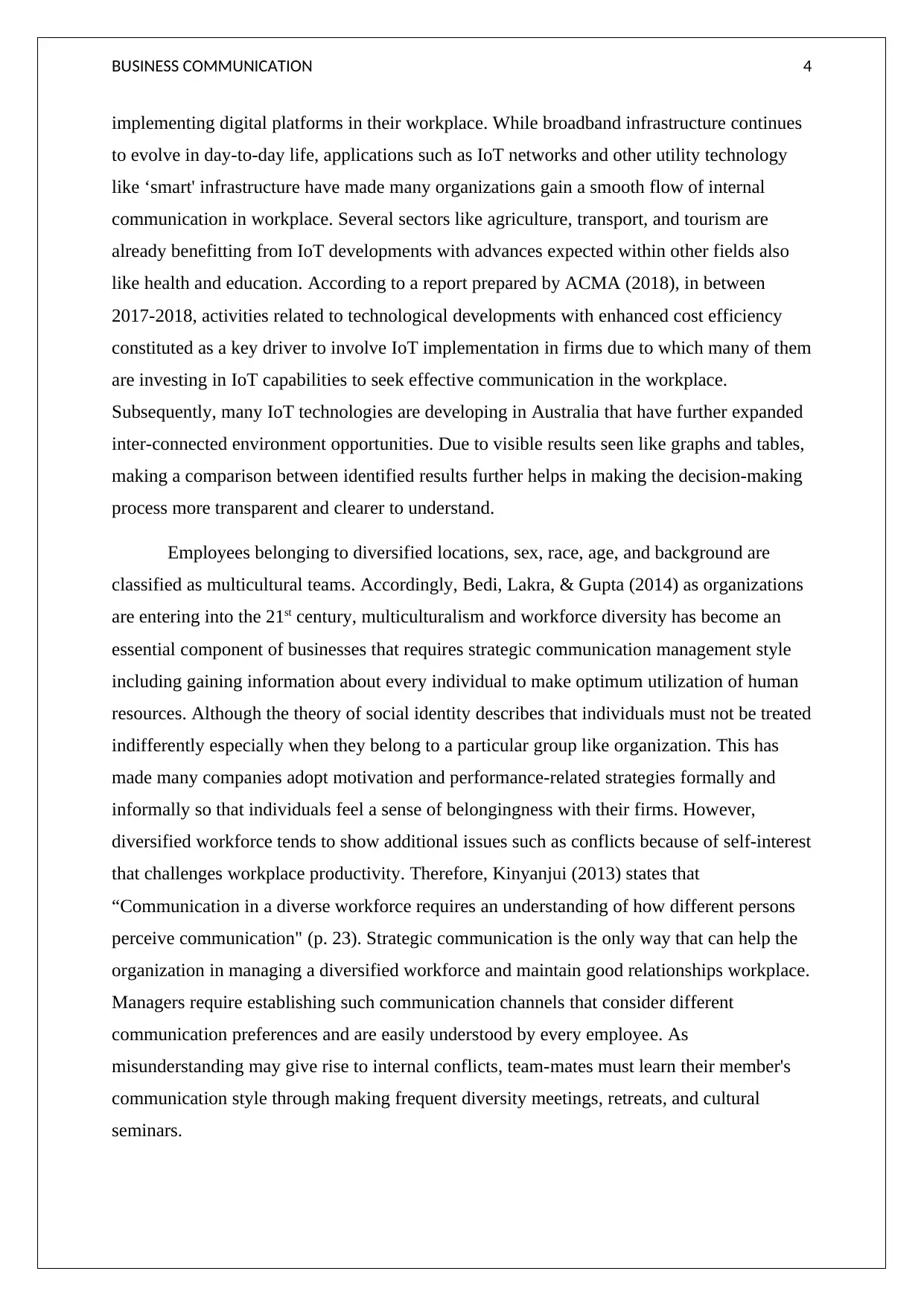
BUSINESS COMMUNICATION 4
implementing digital platforms in their workplace. While broadband infrastructure continues
to evolve in day-to-day life, applications such as IoT networks and other utility technology
like ‘smart' infrastructure have made many organizations gain a smooth flow of internal
communication in workplace. Several sectors like agriculture, transport, and tourism are
already benefitting from IoT developments with advances expected within other fields also
like health and education. According to a report prepared by ACMA (2018), in between
2017-2018, activities related to technological developments with enhanced cost efficiency
constituted as a key driver to involve IoT implementation in firms due to which many of them
are investing in IoT capabilities to seek effective communication in the workplace.
Subsequently, many IoT technologies are developing in Australia that have further expanded
inter-connected environment opportunities. Due to visible results seen like graphs and tables,
making a comparison between identified results further helps in making the decision-making
process more transparent and clearer to understand.
Employees belonging to diversified locations, sex, race, age, and background are
classified as multicultural teams. Accordingly, Bedi, Lakra, & Gupta (2014) as organizations
are entering into the 21st century, multiculturalism and workforce diversity has become an
essential component of businesses that requires strategic communication management style
including gaining information about every individual to make optimum utilization of human
resources. Although the theory of social identity describes that individuals must not be treated
indifferently especially when they belong to a particular group like organization. This has
made many companies adopt motivation and performance-related strategies formally and
informally so that individuals feel a sense of belongingness with their firms. However,
diversified workforce tends to show additional issues such as conflicts because of self-interest
that challenges workplace productivity. Therefore, Kinyanjui (2013) states that
“Communication in a diverse workforce requires an understanding of how different persons
perceive communication" (p. 23). Strategic communication is the only way that can help the
organization in managing a diversified workforce and maintain good relationships workplace.
Managers require establishing such communication channels that consider different
communication preferences and are easily understood by every employee. As
misunderstanding may give rise to internal conflicts, team-mates must learn their member's
communication style through making frequent diversity meetings, retreats, and cultural
seminars.
implementing digital platforms in their workplace. While broadband infrastructure continues
to evolve in day-to-day life, applications such as IoT networks and other utility technology
like ‘smart' infrastructure have made many organizations gain a smooth flow of internal
communication in workplace. Several sectors like agriculture, transport, and tourism are
already benefitting from IoT developments with advances expected within other fields also
like health and education. According to a report prepared by ACMA (2018), in between
2017-2018, activities related to technological developments with enhanced cost efficiency
constituted as a key driver to involve IoT implementation in firms due to which many of them
are investing in IoT capabilities to seek effective communication in the workplace.
Subsequently, many IoT technologies are developing in Australia that have further expanded
inter-connected environment opportunities. Due to visible results seen like graphs and tables,
making a comparison between identified results further helps in making the decision-making
process more transparent and clearer to understand.
Employees belonging to diversified locations, sex, race, age, and background are
classified as multicultural teams. Accordingly, Bedi, Lakra, & Gupta (2014) as organizations
are entering into the 21st century, multiculturalism and workforce diversity has become an
essential component of businesses that requires strategic communication management style
including gaining information about every individual to make optimum utilization of human
resources. Although the theory of social identity describes that individuals must not be treated
indifferently especially when they belong to a particular group like organization. This has
made many companies adopt motivation and performance-related strategies formally and
informally so that individuals feel a sense of belongingness with their firms. However,
diversified workforce tends to show additional issues such as conflicts because of self-interest
that challenges workplace productivity. Therefore, Kinyanjui (2013) states that
“Communication in a diverse workforce requires an understanding of how different persons
perceive communication" (p. 23). Strategic communication is the only way that can help the
organization in managing a diversified workforce and maintain good relationships workplace.
Managers require establishing such communication channels that consider different
communication preferences and are easily understood by every employee. As
misunderstanding may give rise to internal conflicts, team-mates must learn their member's
communication style through making frequent diversity meetings, retreats, and cultural
seminars.
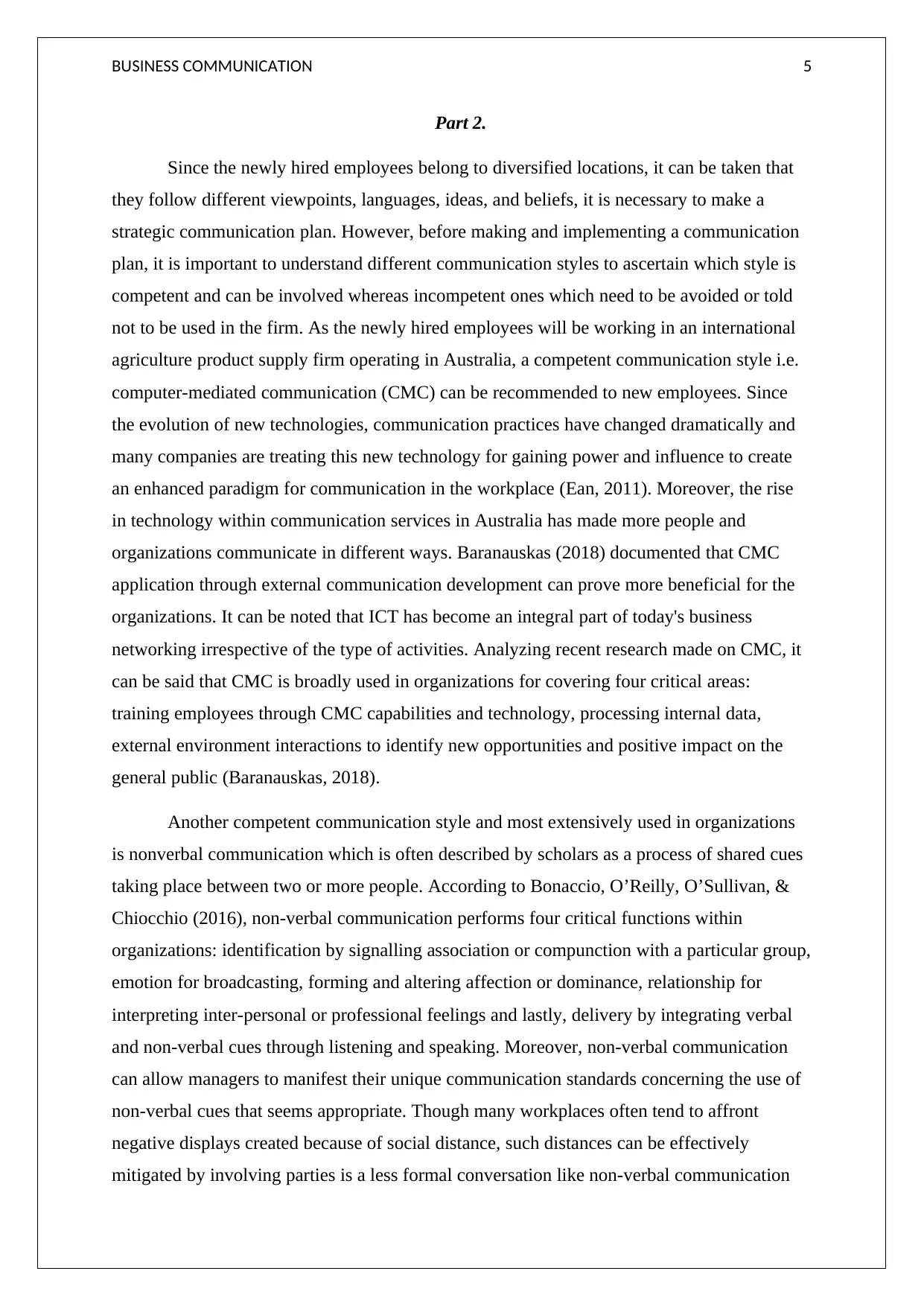
BUSINESS COMMUNICATION 5
Part 2.
Since the newly hired employees belong to diversified locations, it can be taken that
they follow different viewpoints, languages, ideas, and beliefs, it is necessary to make a
strategic communication plan. However, before making and implementing a communication
plan, it is important to understand different communication styles to ascertain which style is
competent and can be involved whereas incompetent ones which need to be avoided or told
not to be used in the firm. As the newly hired employees will be working in an international
agriculture product supply firm operating in Australia, a competent communication style i.e.
computer-mediated communication (CMC) can be recommended to new employees. Since
the evolution of new technologies, communication practices have changed dramatically and
many companies are treating this new technology for gaining power and influence to create
an enhanced paradigm for communication in the workplace (Ean, 2011). Moreover, the rise
in technology within communication services in Australia has made more people and
organizations communicate in different ways. Baranauskas (2018) documented that CMC
application through external communication development can prove more beneficial for the
organizations. It can be noted that ICT has become an integral part of today's business
networking irrespective of the type of activities. Analyzing recent research made on CMC, it
can be said that CMC is broadly used in organizations for covering four critical areas:
training employees through CMC capabilities and technology, processing internal data,
external environment interactions to identify new opportunities and positive impact on the
general public (Baranauskas, 2018).
Another competent communication style and most extensively used in organizations
is nonverbal communication which is often described by scholars as a process of shared cues
taking place between two or more people. According to Bonaccio, O’Reilly, O’Sullivan, &
Chiocchio (2016), non-verbal communication performs four critical functions within
organizations: identification by signalling association or compunction with a particular group,
emotion for broadcasting, forming and altering affection or dominance, relationship for
interpreting inter-personal or professional feelings and lastly, delivery by integrating verbal
and non-verbal cues through listening and speaking. Moreover, non-verbal communication
can allow managers to manifest their unique communication standards concerning the use of
non-verbal cues that seems appropriate. Though many workplaces often tend to affront
negative displays created because of social distance, such distances can be effectively
mitigated by involving parties is a less formal conversation like non-verbal communication
Part 2.
Since the newly hired employees belong to diversified locations, it can be taken that
they follow different viewpoints, languages, ideas, and beliefs, it is necessary to make a
strategic communication plan. However, before making and implementing a communication
plan, it is important to understand different communication styles to ascertain which style is
competent and can be involved whereas incompetent ones which need to be avoided or told
not to be used in the firm. As the newly hired employees will be working in an international
agriculture product supply firm operating in Australia, a competent communication style i.e.
computer-mediated communication (CMC) can be recommended to new employees. Since
the evolution of new technologies, communication practices have changed dramatically and
many companies are treating this new technology for gaining power and influence to create
an enhanced paradigm for communication in the workplace (Ean, 2011). Moreover, the rise
in technology within communication services in Australia has made more people and
organizations communicate in different ways. Baranauskas (2018) documented that CMC
application through external communication development can prove more beneficial for the
organizations. It can be noted that ICT has become an integral part of today's business
networking irrespective of the type of activities. Analyzing recent research made on CMC, it
can be said that CMC is broadly used in organizations for covering four critical areas:
training employees through CMC capabilities and technology, processing internal data,
external environment interactions to identify new opportunities and positive impact on the
general public (Baranauskas, 2018).
Another competent communication style and most extensively used in organizations
is nonverbal communication which is often described by scholars as a process of shared cues
taking place between two or more people. According to Bonaccio, O’Reilly, O’Sullivan, &
Chiocchio (2016), non-verbal communication performs four critical functions within
organizations: identification by signalling association or compunction with a particular group,
emotion for broadcasting, forming and altering affection or dominance, relationship for
interpreting inter-personal or professional feelings and lastly, delivery by integrating verbal
and non-verbal cues through listening and speaking. Moreover, non-verbal communication
can allow managers to manifest their unique communication standards concerning the use of
non-verbal cues that seems appropriate. Though many workplaces often tend to affront
negative displays created because of social distance, such distances can be effectively
mitigated by involving parties is a less formal conversation like non-verbal communication
⊘ This is a preview!⊘
Do you want full access?
Subscribe today to unlock all pages.

Trusted by 1+ million students worldwide
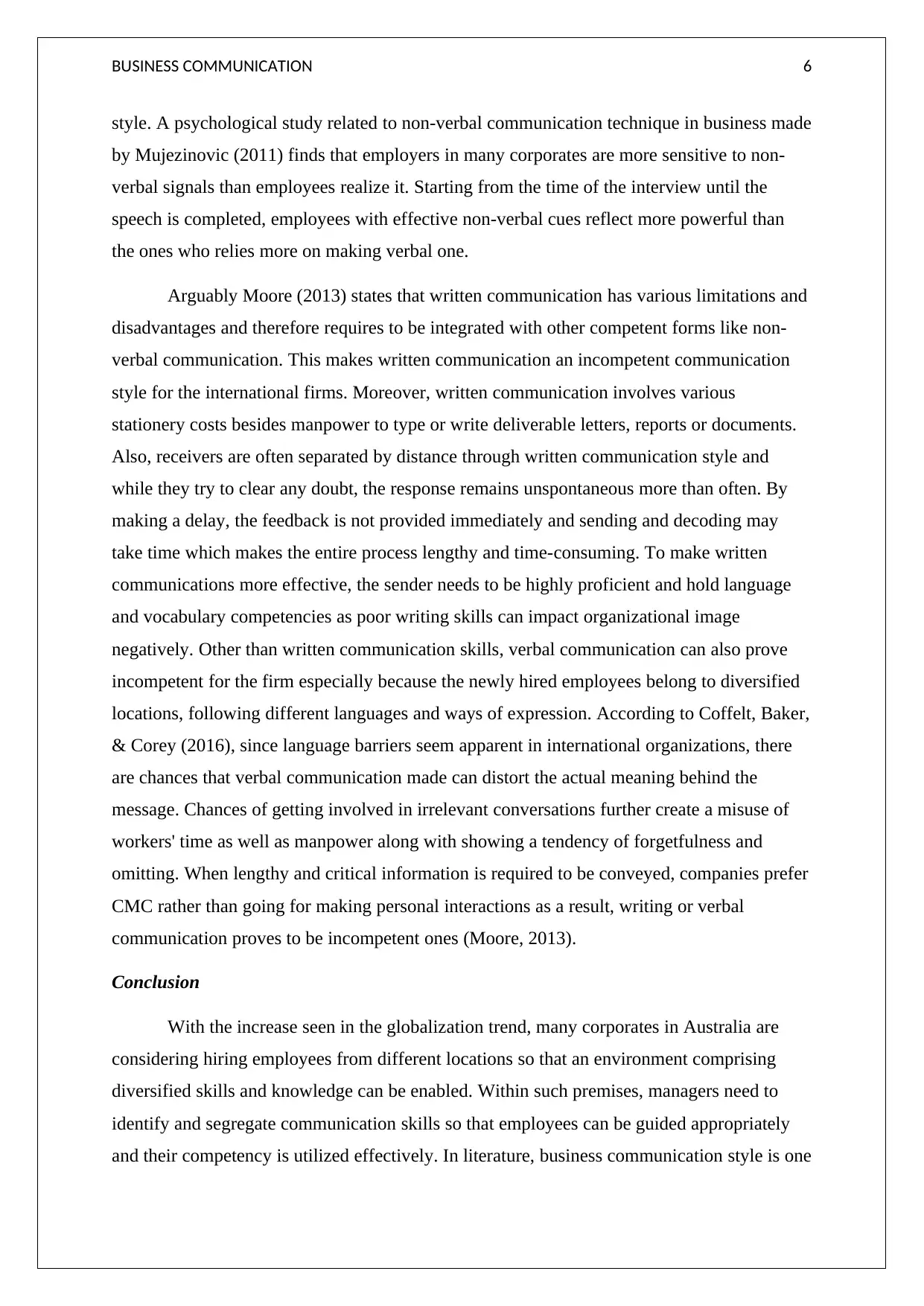
BUSINESS COMMUNICATION 6
style. A psychological study related to non-verbal communication technique in business made
by Mujezinovic (2011) finds that employers in many corporates are more sensitive to non-
verbal signals than employees realize it. Starting from the time of the interview until the
speech is completed, employees with effective non-verbal cues reflect more powerful than
the ones who relies more on making verbal one.
Arguably Moore (2013) states that written communication has various limitations and
disadvantages and therefore requires to be integrated with other competent forms like non-
verbal communication. This makes written communication an incompetent communication
style for the international firms. Moreover, written communication involves various
stationery costs besides manpower to type or write deliverable letters, reports or documents.
Also, receivers are often separated by distance through written communication style and
while they try to clear any doubt, the response remains unspontaneous more than often. By
making a delay, the feedback is not provided immediately and sending and decoding may
take time which makes the entire process lengthy and time-consuming. To make written
communications more effective, the sender needs to be highly proficient and hold language
and vocabulary competencies as poor writing skills can impact organizational image
negatively. Other than written communication skills, verbal communication can also prove
incompetent for the firm especially because the newly hired employees belong to diversified
locations, following different languages and ways of expression. According to Coffelt, Baker,
& Corey (2016), since language barriers seem apparent in international organizations, there
are chances that verbal communication made can distort the actual meaning behind the
message. Chances of getting involved in irrelevant conversations further create a misuse of
workers' time as well as manpower along with showing a tendency of forgetfulness and
omitting. When lengthy and critical information is required to be conveyed, companies prefer
CMC rather than going for making personal interactions as a result, writing or verbal
communication proves to be incompetent ones (Moore, 2013).
Conclusion
With the increase seen in the globalization trend, many corporates in Australia are
considering hiring employees from different locations so that an environment comprising
diversified skills and knowledge can be enabled. Within such premises, managers need to
identify and segregate communication skills so that employees can be guided appropriately
and their competency is utilized effectively. In literature, business communication style is one
style. A psychological study related to non-verbal communication technique in business made
by Mujezinovic (2011) finds that employers in many corporates are more sensitive to non-
verbal signals than employees realize it. Starting from the time of the interview until the
speech is completed, employees with effective non-verbal cues reflect more powerful than
the ones who relies more on making verbal one.
Arguably Moore (2013) states that written communication has various limitations and
disadvantages and therefore requires to be integrated with other competent forms like non-
verbal communication. This makes written communication an incompetent communication
style for the international firms. Moreover, written communication involves various
stationery costs besides manpower to type or write deliverable letters, reports or documents.
Also, receivers are often separated by distance through written communication style and
while they try to clear any doubt, the response remains unspontaneous more than often. By
making a delay, the feedback is not provided immediately and sending and decoding may
take time which makes the entire process lengthy and time-consuming. To make written
communications more effective, the sender needs to be highly proficient and hold language
and vocabulary competencies as poor writing skills can impact organizational image
negatively. Other than written communication skills, verbal communication can also prove
incompetent for the firm especially because the newly hired employees belong to diversified
locations, following different languages and ways of expression. According to Coffelt, Baker,
& Corey (2016), since language barriers seem apparent in international organizations, there
are chances that verbal communication made can distort the actual meaning behind the
message. Chances of getting involved in irrelevant conversations further create a misuse of
workers' time as well as manpower along with showing a tendency of forgetfulness and
omitting. When lengthy and critical information is required to be conveyed, companies prefer
CMC rather than going for making personal interactions as a result, writing or verbal
communication proves to be incompetent ones (Moore, 2013).
Conclusion
With the increase seen in the globalization trend, many corporates in Australia are
considering hiring employees from different locations so that an environment comprising
diversified skills and knowledge can be enabled. Within such premises, managers need to
identify and segregate communication skills so that employees can be guided appropriately
and their competency is utilized effectively. In literature, business communication style is one
Paraphrase This Document
Need a fresh take? Get an instant paraphrase of this document with our AI Paraphraser
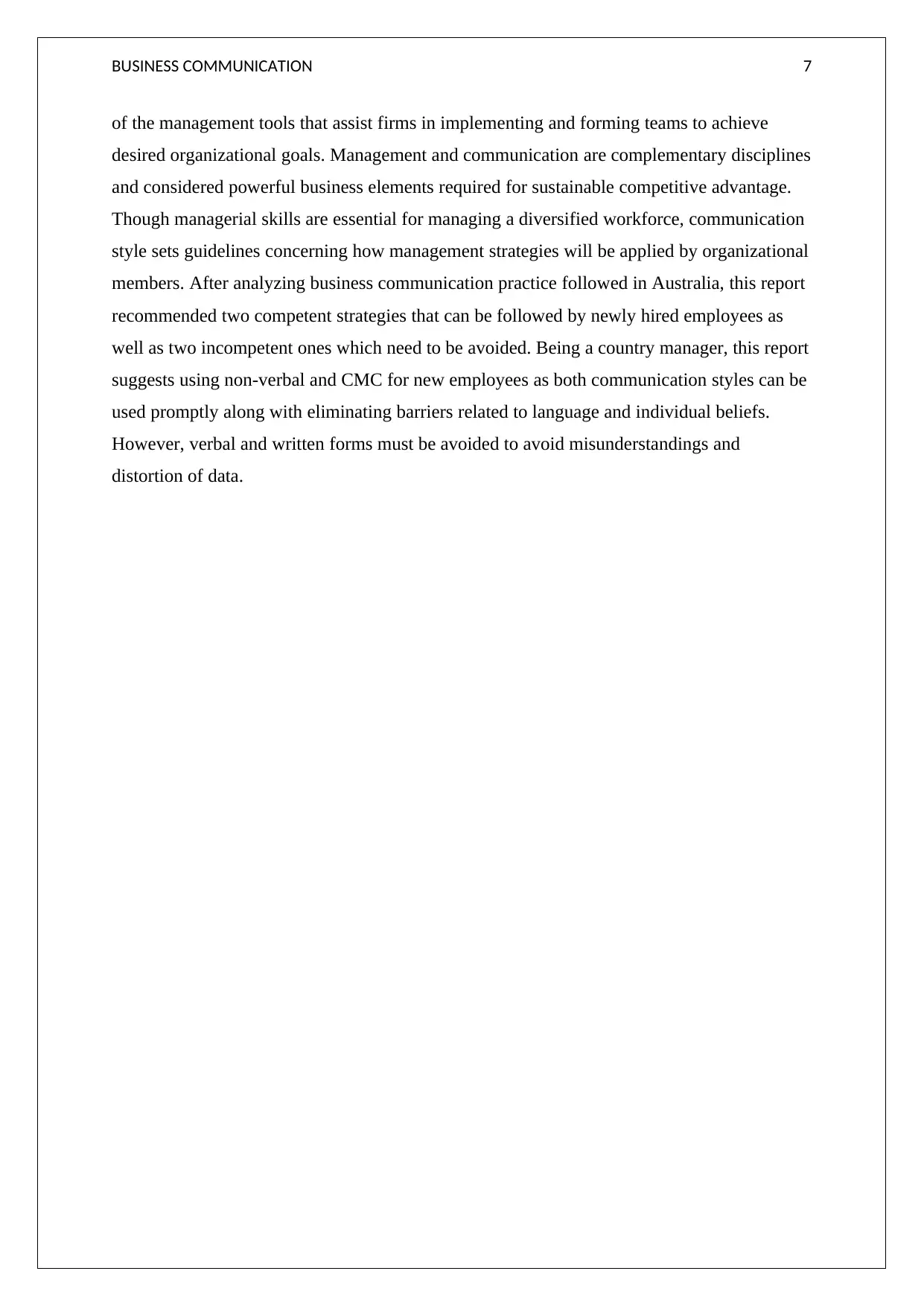
BUSINESS COMMUNICATION 7
of the management tools that assist firms in implementing and forming teams to achieve
desired organizational goals. Management and communication are complementary disciplines
and considered powerful business elements required for sustainable competitive advantage.
Though managerial skills are essential for managing a diversified workforce, communication
style sets guidelines concerning how management strategies will be applied by organizational
members. After analyzing business communication practice followed in Australia, this report
recommended two competent strategies that can be followed by newly hired employees as
well as two incompetent ones which need to be avoided. Being a country manager, this report
suggests using non-verbal and CMC for new employees as both communication styles can be
used promptly along with eliminating barriers related to language and individual beliefs.
However, verbal and written forms must be avoided to avoid misunderstandings and
distortion of data.
of the management tools that assist firms in implementing and forming teams to achieve
desired organizational goals. Management and communication are complementary disciplines
and considered powerful business elements required for sustainable competitive advantage.
Though managerial skills are essential for managing a diversified workforce, communication
style sets guidelines concerning how management strategies will be applied by organizational
members. After analyzing business communication practice followed in Australia, this report
recommended two competent strategies that can be followed by newly hired employees as
well as two incompetent ones which need to be avoided. Being a country manager, this report
suggests using non-verbal and CMC for new employees as both communication styles can be
used promptly along with eliminating barriers related to language and individual beliefs.
However, verbal and written forms must be avoided to avoid misunderstandings and
distortion of data.
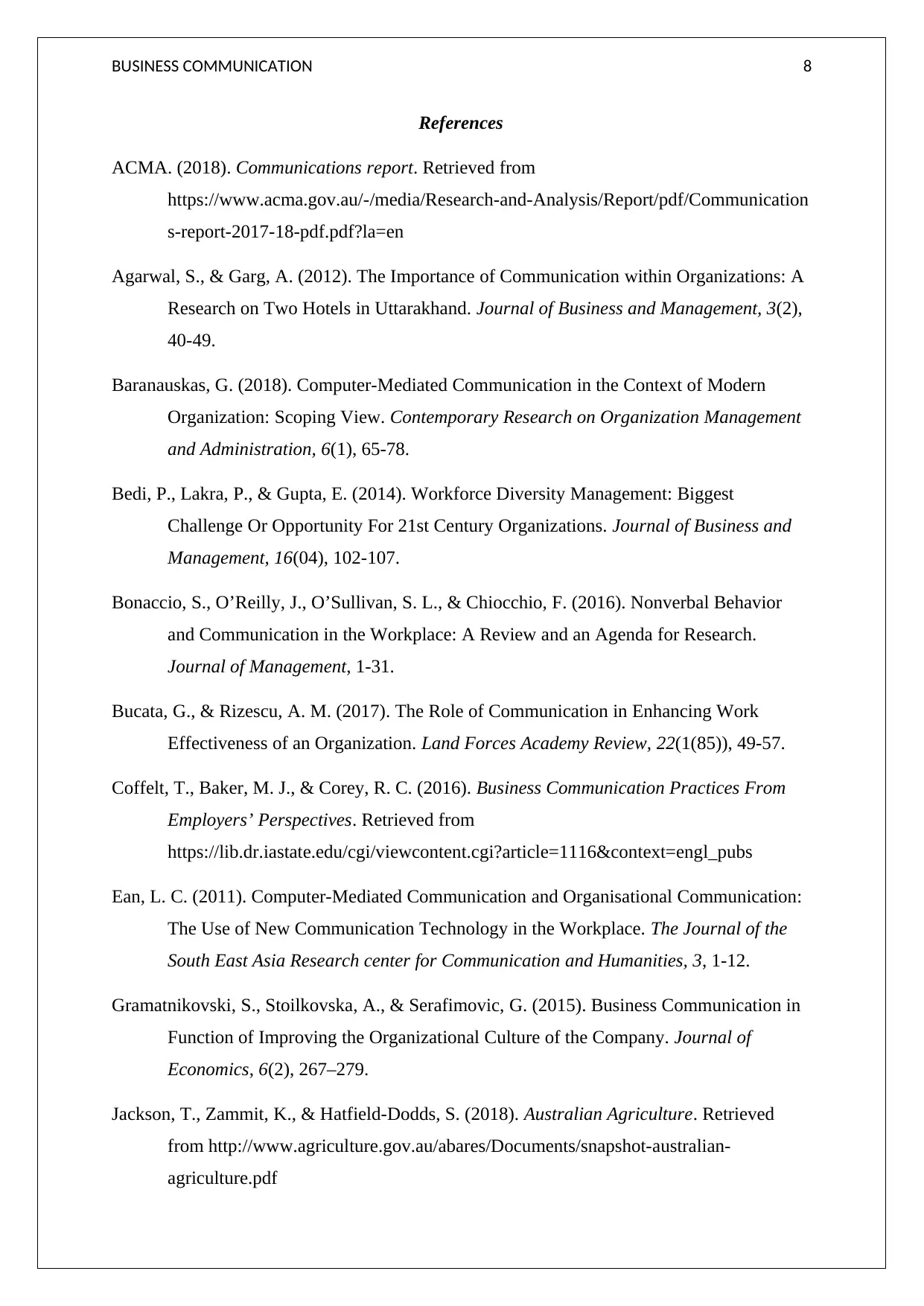
BUSINESS COMMUNICATION 8
References
ACMA. (2018). Communications report. Retrieved from
https://www.acma.gov.au/-/media/Research-and-Analysis/Report/pdf/Communication
s-report-2017-18-pdf.pdf?la=en
Agarwal, S., & Garg, A. (2012). The Importance of Communication within Organizations: A
Research on Two Hotels in Uttarakhand. Journal of Business and Management, 3(2),
40-49.
Baranauskas, G. (2018). Computer-Mediated Communication in the Context of Modern
Organization: Scoping View. Contemporary Research on Organization Management
and Administration, 6(1), 65-78.
Bedi, P., Lakra, P., & Gupta, E. (2014). Workforce Diversity Management: Biggest
Challenge Or Opportunity For 21st Century Organizations. Journal of Business and
Management, 16(04), 102-107.
Bonaccio, S., O’Reilly, J., O’Sullivan, S. L., & Chiocchio, F. (2016). Nonverbal Behavior
and Communication in the Workplace: A Review and an Agenda for Research.
Journal of Management, 1-31.
Bucata, G., & Rizescu, A. M. (2017). The Role of Communication in Enhancing Work
Effectiveness of an Organization. Land Forces Academy Review, 22(1(85)), 49-57.
Coffelt, T., Baker, M. J., & Corey, R. C. (2016). Business Communication Practices From
Employers’ Perspectives. Retrieved from
https://lib.dr.iastate.edu/cgi/viewcontent.cgi?article=1116&context=engl_pubs
Ean, L. C. (2011). Computer-Mediated Communication and Organisational Communication:
The Use of New Communication Technology in the Workplace. The Journal of the
South East Asia Research center for Communication and Humanities, 3, 1-12.
Gramatnikovski, S., Stoilkovska, A., & Serafimovic, G. (2015). Business Communication in
Function of Improving the Organizational Culture of the Company. Journal of
Economics, 6(2), 267–279.
Jackson, T., Zammit, K., & Hatfield-Dodds, S. (2018). Australian Agriculture. Retrieved
from http://www.agriculture.gov.au/abares/Documents/snapshot-australian-
agriculture.pdf
References
ACMA. (2018). Communications report. Retrieved from
https://www.acma.gov.au/-/media/Research-and-Analysis/Report/pdf/Communication
s-report-2017-18-pdf.pdf?la=en
Agarwal, S., & Garg, A. (2012). The Importance of Communication within Organizations: A
Research on Two Hotels in Uttarakhand. Journal of Business and Management, 3(2),
40-49.
Baranauskas, G. (2018). Computer-Mediated Communication in the Context of Modern
Organization: Scoping View. Contemporary Research on Organization Management
and Administration, 6(1), 65-78.
Bedi, P., Lakra, P., & Gupta, E. (2014). Workforce Diversity Management: Biggest
Challenge Or Opportunity For 21st Century Organizations. Journal of Business and
Management, 16(04), 102-107.
Bonaccio, S., O’Reilly, J., O’Sullivan, S. L., & Chiocchio, F. (2016). Nonverbal Behavior
and Communication in the Workplace: A Review and an Agenda for Research.
Journal of Management, 1-31.
Bucata, G., & Rizescu, A. M. (2017). The Role of Communication in Enhancing Work
Effectiveness of an Organization. Land Forces Academy Review, 22(1(85)), 49-57.
Coffelt, T., Baker, M. J., & Corey, R. C. (2016). Business Communication Practices From
Employers’ Perspectives. Retrieved from
https://lib.dr.iastate.edu/cgi/viewcontent.cgi?article=1116&context=engl_pubs
Ean, L. C. (2011). Computer-Mediated Communication and Organisational Communication:
The Use of New Communication Technology in the Workplace. The Journal of the
South East Asia Research center for Communication and Humanities, 3, 1-12.
Gramatnikovski, S., Stoilkovska, A., & Serafimovic, G. (2015). Business Communication in
Function of Improving the Organizational Culture of the Company. Journal of
Economics, 6(2), 267–279.
Jackson, T., Zammit, K., & Hatfield-Dodds, S. (2018). Australian Agriculture. Retrieved
from http://www.agriculture.gov.au/abares/Documents/snapshot-australian-
agriculture.pdf
⊘ This is a preview!⊘
Do you want full access?
Subscribe today to unlock all pages.

Trusted by 1+ million students worldwide
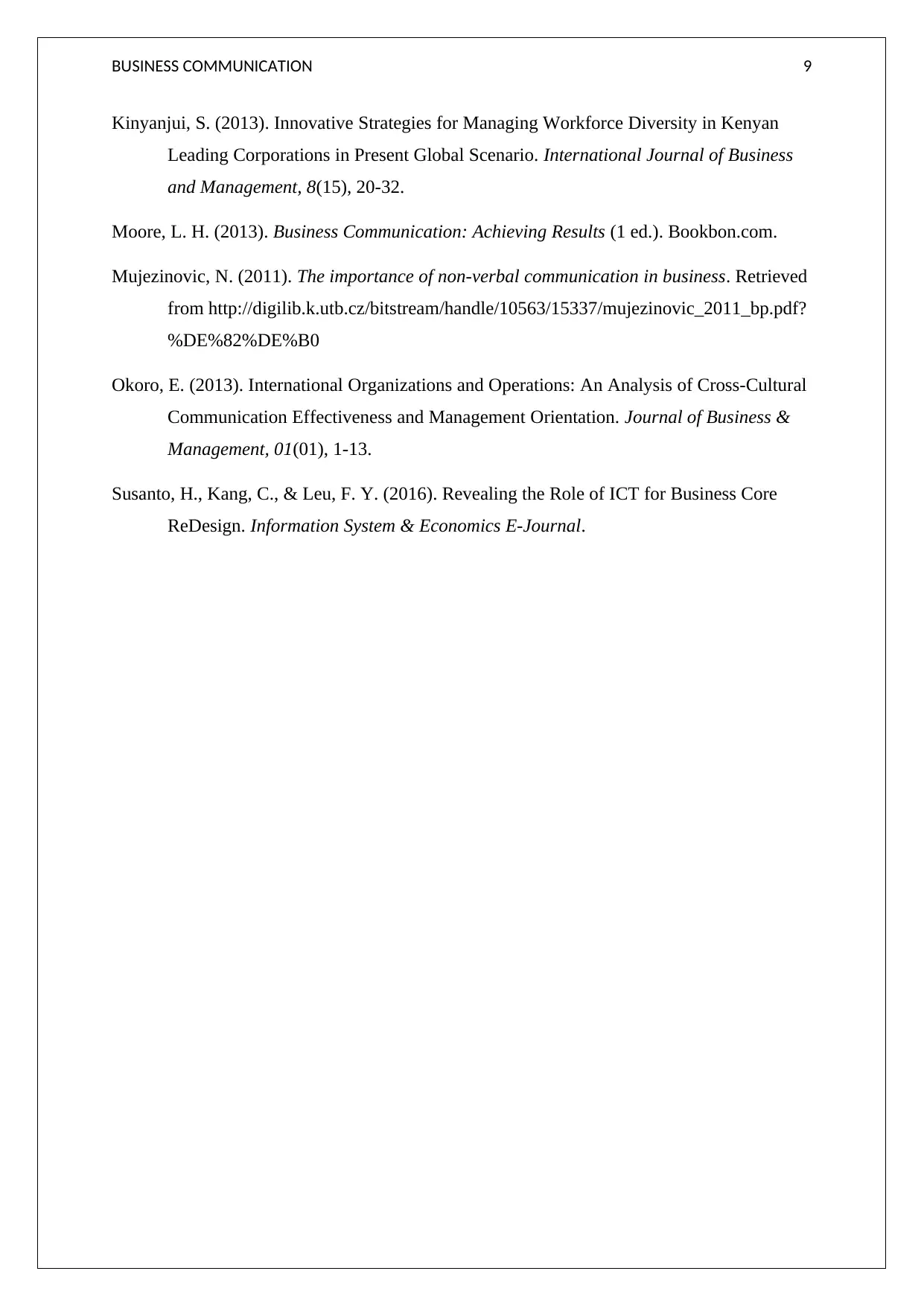
BUSINESS COMMUNICATION 9
Kinyanjui, S. (2013). Innovative Strategies for Managing Workforce Diversity in Kenyan
Leading Corporations in Present Global Scenario. International Journal of Business
and Management, 8(15), 20-32.
Moore, L. H. (2013). Business Communication: Achieving Results (1 ed.). Bookbon.com.
Mujezinovic, N. (2011). The importance of non-verbal communication in business. Retrieved
from http://digilib.k.utb.cz/bitstream/handle/10563/15337/mujezinovic_2011_bp.pdf?
%DE%82%DE%B0
Okoro, E. (2013). International Organizations and Operations: An Analysis of Cross-Cultural
Communication Effectiveness and Management Orientation. Journal of Business &
Management, 01(01), 1-13.
Susanto, H., Kang, C., & Leu, F. Y. (2016). Revealing the Role of ICT for Business Core
ReDesign. Information System & Economics E-Journal.
Kinyanjui, S. (2013). Innovative Strategies for Managing Workforce Diversity in Kenyan
Leading Corporations in Present Global Scenario. International Journal of Business
and Management, 8(15), 20-32.
Moore, L. H. (2013). Business Communication: Achieving Results (1 ed.). Bookbon.com.
Mujezinovic, N. (2011). The importance of non-verbal communication in business. Retrieved
from http://digilib.k.utb.cz/bitstream/handle/10563/15337/mujezinovic_2011_bp.pdf?
%DE%82%DE%B0
Okoro, E. (2013). International Organizations and Operations: An Analysis of Cross-Cultural
Communication Effectiveness and Management Orientation. Journal of Business &
Management, 01(01), 1-13.
Susanto, H., Kang, C., & Leu, F. Y. (2016). Revealing the Role of ICT for Business Core
ReDesign. Information System & Economics E-Journal.
1 out of 10
Related Documents
Your All-in-One AI-Powered Toolkit for Academic Success.
+13062052269
info@desklib.com
Available 24*7 on WhatsApp / Email
![[object Object]](/_next/static/media/star-bottom.7253800d.svg)
Unlock your academic potential
Copyright © 2020–2025 A2Z Services. All Rights Reserved. Developed and managed by ZUCOL.




